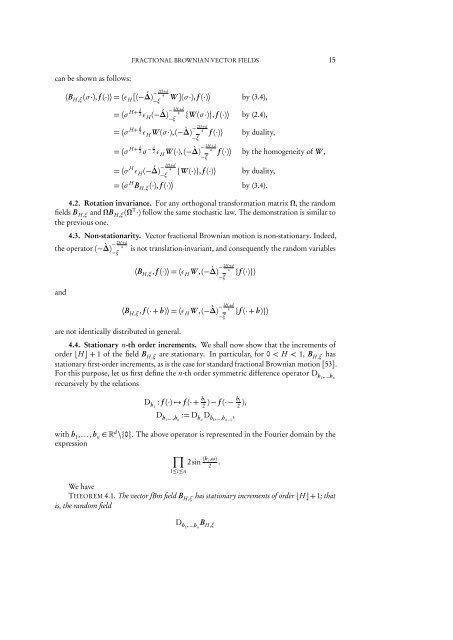FRACTIONAL BROWNIAN VECTOR FIELDS 1. Introduction. A one ...
FRACTIONAL BROWNIAN VECTOR FIELDS 1. Introduction. A one ...
FRACTIONAL BROWNIAN VECTOR FIELDS 1. Introduction. A one ...
Create successful ePaper yourself
Turn your PDF publications into a flip-book with our unique Google optimized e-Paper software.
can be shown as follows:<br />
〈B H,ξ (σ·), f (·)〉 = 〈ε H [(−<br />
<strong>FRACTIONAL</strong> <strong>BROWNIAN</strong> <strong>VECTOR</strong> <strong>FIELDS</strong> 15<br />
= 〈σ H+ d 2 εH (−<br />
2H+d<br />
− 4 ´∆) W ](σ·), f (·)〉 by (3.4),<br />
−ξ<br />
= 〈σ H+ d 2 εH W (σ·),(−<br />
= 〈σ H+ d 2 σ<br />
− d 2 εH W (·),(−<br />
= 〈σ H ε H (−<br />
2H+d<br />
− 4 ´∆) {W (σ·)}, f (·)〉 by (2.4),<br />
−ξ<br />
2H+d<br />
− 4 `∆)<br />
−ξ<br />
2H+d<br />
− 4 `∆)<br />
−ξ<br />
f (·)〉<br />
by duality,<br />
f (·)〉 by the homogeneity of W ,<br />
2H+d<br />
− 4 ´∆) {W (·)}, f (·)〉 by duality,<br />
−ξ<br />
= 〈σ H B H,ξ (·), f (·)〉 by (3.4).<br />
4.2. Rotation invariance. For any orthogonal transformation matrix Ω, the random<br />
fields B H,ξ and ΩB H,ξ (Ω T·) follow the same stochastic law. The demonstration is similar to<br />
the previous <strong>one</strong>.<br />
4.3. Non-stationarity. Vector fractional Brownian motion is non-stationary. Indeed,<br />
2H+d<br />
− 4<br />
the operator (− `∆) is not translation-invariant, and consequently the random variables<br />
−ξ<br />
and<br />
〈B H,ξ , f (·)〉 = 〈ε H W ,(−<br />
〈B H,ξ , f (· + h)〉 = 〈ε H W ,(−<br />
are not identically distributed in general.<br />
2H+d<br />
− 4 `∆) {f (·)}〉<br />
−ξ<br />
2H+d<br />
− 4 `∆) {f (· + h)}〉<br />
−ξ<br />
4.4. Stationary n-th order increments. We shall now show that the increments of<br />
order ⌊H⌋ + 1 of the field B H,ξ are stationary. In particular, for 0 < H < 1, B H,ξ has<br />
stationary first-order increments, as is the case for standard fractional Brownian motion [53].<br />
For this purpose, let us first define the n-th order symmetric difference operator D h1 ,...,h n<br />
recursively by the relations<br />
D h1<br />
: f (·) → f (· + h 1<br />
2 ) − f (· − h 1<br />
2 ),<br />
D h1 ,...,h n<br />
:= D hn<br />
D h1 ,...,h n−1<br />
,<br />
with h 1 ,...,h n ∈ d \{0}. The above operator is represented in the Fourier domain by the<br />
expression<br />
∏<br />
1≤i≤n<br />
2sin 〈h i ,ω〉<br />
2<br />
.<br />
We have<br />
THEOREM 4.<strong>1.</strong> The vector fBm field B H,ξ has stationary increments of order ⌊H⌋+1; that<br />
is, the random field<br />
D h1 ,...,h n<br />
B H,ξ
















